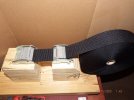I have to ask!
I have been seriously engaged in sharpening things for some time now. My arms and legs are substantially naked these days.
But I have tried to shave my face with my best efforts on various utility knives, pocket knives, and even with very thin Asian kitchen cutlery. And it is not happening, at least not without a lot of pain and a little blood.
So my question is: How many of the guys on this site who talk about getting their knives "shaving sharp" are talking about shaving their faces, and how many are talking about shaving arms and legs?
There is a huge difference, in my experience. I'm not talking about razors or other specialty blades specifically designed to shave the face.
I have been seriously engaged in sharpening things for some time now. My arms and legs are substantially naked these days.
But I have tried to shave my face with my best efforts on various utility knives, pocket knives, and even with very thin Asian kitchen cutlery. And it is not happening, at least not without a lot of pain and a little blood.
So my question is: How many of the guys on this site who talk about getting their knives "shaving sharp" are talking about shaving their faces, and how many are talking about shaving arms and legs?
There is a huge difference, in my experience. I'm not talking about razors or other specialty blades specifically designed to shave the face.


